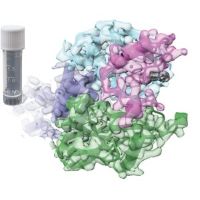Specification
| Description | Recombinant protein from the full-length sequence of homo sapiens interferon induced transmembrane protein 1 (IFITM1) (NM_003641). |
| Organism | Homo sapiens (Human) |
| Expression Host | Human Cells |
| Tag Info | His or DYKDDDDK. Please contact us if you need further information or require specific designed tag. |
| Purity | Greater than 90% by SDS-PAGE gel |
| Uniprot ID | P13164 |
| Entry Name | IFM1_HUMAN |
| Gene Names | IFITM1 CD225 IFI17 |
| Alternative Gene Names | CD225 IFI17 |
| Alternative Protein Names | Interferon-induced transmembrane protein 1 (Dispanin subfamily A member 2a) (DSPA2a) (Interferon-induced protein 17) (Interferon-inducible protein 9-27) (Leu-13 antigen) (CD antigen CD225) |
| Application | Antigens, Western, ELISA and other in vitro binding or in vivo functional assays, and protein-protein interaction studies; For research & development use only! |
| Buffer | Purified protein formulated in a sterile solution of PBS buffer, pH7.2, without any preservatives |
| Endotoxin | Endotoxin level is < 0.1 ng/µg of protein (<1EU /µg) |
| Length | 125 |
| Molecular Weight(Da) | 13964 |
| Protein Sequence | (The sequence of expressed protein may have some variation from the sequence shown below. Please contact us for the exact sequence.) MHKEEHEVAVLGPPPSTILPRSTVINIHSETSVPDHVVWSLFNTLFLNWCCLGFIAFAYSVKSRDRKMVGDVTGAQAYASTAKCLNIWALILGILMTIGFILLLVFGSVTVYHIMLQIIQEKRGY |
Background
| Function | FUNCTION: IFN-induced antiviral protein which inhibits the entry of viruses to the host cell cytoplasm, permitting endocytosis, but preventing subsequent viral fusion and release of viral contents into the cytosol. Active against multiple viruses, including influenza A virus, SARS coronaviruses (SARS-CoV and SARS-CoV-2), Marburg virus (MARV), Ebola virus (EBOV), Dengue virus (DNV), West Nile virus (WNV), human immunodeficiency virus type 1 (HIV-1) and hepatitis C virus (HCV) (PubMed:26354436, PubMed:33270927). Can inhibit: influenza virus hemagglutinin protein-mediated viral entry, MARV and EBOV GP1,2-mediated viral entry and SARS-CoV and SARS-CoV-2 S protein-mediated viral entry. Also implicated in cell adhesion and control of cell growth and migration (PubMed:33270927). Inhibits SARS-CoV-2 S protein-mediated syncytia formation (PubMed:33051876). Plays a key role in the antiproliferative action of IFN-gamma either by inhibiting the ERK activation or by arresting cell growth in G1 phase in a p53-dependent manner. Acts as a positive regulator of osteoblast differentiation. In hepatocytes, IFITM proteins act in a coordinated manner to restrict HCV infection by targeting the endocytosed HCV virion for lysosomal degradation (PubMed:26354436). IFITM2 and IFITM3 display anti-HCV activity that may complement the anti-HCV activity of IFITM1 by inhibiting the late stages of HCV entry, possibly in a coordinated manner by trapping the virion in the endosomal pathway and targeting it for degradation at the lysosome (PubMed:26354436). {ECO:0000269|PubMed:16847454, ECO:0000269|PubMed:20064371, ECO:0000269|PubMed:20838853, ECO:0000269|PubMed:21177806, ECO:0000269|PubMed:21253575, ECO:0000269|PubMed:21976647, ECO:0000269|PubMed:22479637, ECO:0000269|PubMed:22634173, ECO:0000269|PubMed:26354436, ECO:0000269|PubMed:33051876, ECO:0000269|PubMed:33270927}. |
| Pathway | |
| Protein Families | CD225/Dispanin family |
| Tissue Specificity | Bone (at protein level). Levels greatly elevated in colon cancer, cervical cancer, esophageal cancer and ovarian cancer. Expressed in glioma cell lines. {ECO:0000269|PubMed:20838853, ECO:0000269|PubMed:22634173}. |
QC Data
| Note | Please contact us for QC Data |
| Product Image (Reference Only) |  |

